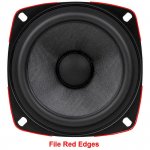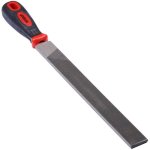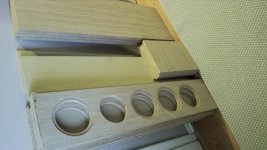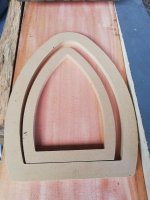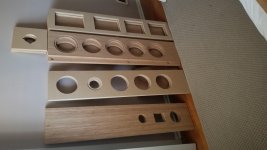Mechanical pressure on the brace, which is probably the result of air pressure.
Air pressure inside the box is relatively immaterial vrs what comes thru the cabinet from the reactive force of the basket.
Copy the whole design and work on the copy (always a good idea).
You should have a look atsome of my drawing files :^)
dave
My comments on the 'bridge' were regarding the primary mode of the panel, irrespective of how it was excited. Are you suggesting this is insufficient? The panel would, afterall, move in more than one mode..Air pressure inside the box is relatively immaterial vrs what comes thru the cabinet from the reactive force of the basket.
Feel free to share. I recall admiring your illustrations back in my TL days.You should have a look atsome of my drawing files :^)
Pressure will only be an issue at very low frequencies, and only half of the energy from moving air comes off the back of the cone. And that pressure will be equal on both sides of the brace for no net force.
All the reaction forces are directly transmitted to the cabinet at all frequencies.
It is easy to make a cabinet that is immune to LF resonances.
You’d have to look over my shoulder.
dave
All the reaction forces are directly transmitted to the cabinet at all frequencies.
It is easy to make a cabinet that is immune to LF resonances.
Feel free to share
You’d have to look over my shoulder.
dave
An update to Hamlets and another surprise.
I have been dollying up my own Elsinores which date back to Mk2 circa and hence need the old square fill-in for the waveguide. I will post photo some time soon, but what I used was Duratex roll-on textured finish.
Duratex Video
I have bought the MFC drivers for the Hamlets, they are here now. The new drivers will be fitted and the box will be given the Duratex treatment. Within a matter of weeks will be doing the computer modeling and get the crossover worked out. It will be the same crossover as I used with the earlier HDS drivers, but there is expected to be between 3-5 changes in values, the topology will be exactly the same.
Now for a little surprise, take a look at this photo:
Dayton B452-AIR
Now as it is, it is cheap and great for a computer speaker. But I am going to take it much further and I will publish the details so that this will be a great little satellite speaker.
I will let you in on the first step that I have already done. The AMT tweeter is of course, the attraction here, but it uses a cheap (only so-so OK) polypropylene mid-bass driver... so we replace it with this:
IMPORTANT: Must be the 8 Ohm version as shown - Dayton PC105-8
Just replace with this much better driver, BUT it is not a straight fit, you will need to file away not quite a millimeter where the four holes are, as it is a slightly larger driver. The existing mounting holes are just fine.
Later, we shall develop this into something more advanced and take advantage of the drivers that are now both of them good, and not just the AMT tweeter.
Use it like that for now, it is amazing value and we shall make it better still after I have done some measurements etc.
4" FULL RANGE POLY CONE DRIVER - DAYTON AUDIO
SMOOTH RESPONSE WITH TRUE FULL-RANGE REPRODUCTION
Dayton Audio’s PC105 4” full-range driver will deliver smooth and natural response from extremely compact designs. When used in line arrays, portable speakers, sound bars, or as a dedicated midrange in 3-way designs this driver will prove to be an excellent value.
Poly damped woven glass fibre cone controls cone break-up and provides a smooth roll-off
Copper cap keeps inductance under control and extends high frequency response
1" vented aluminium voice coil former and vented pole piece for high power handling
High energy ferrite magnet increases BL for higher efficiency and more output
Smooth response with true full-range reproduction for simple speaker designs.
I have been dollying up my own Elsinores which date back to Mk2 circa and hence need the old square fill-in for the waveguide. I will post photo some time soon, but what I used was Duratex roll-on textured finish.
Duratex Video
I have bought the MFC drivers for the Hamlets, they are here now. The new drivers will be fitted and the box will be given the Duratex treatment. Within a matter of weeks will be doing the computer modeling and get the crossover worked out. It will be the same crossover as I used with the earlier HDS drivers, but there is expected to be between 3-5 changes in values, the topology will be exactly the same.
Now for a little surprise, take a look at this photo:
An externally hosted image should be here but it was not working when we last tested it.
Dayton B452-AIR
Now as it is, it is cheap and great for a computer speaker. But I am going to take it much further and I will publish the details so that this will be a great little satellite speaker.
I will let you in on the first step that I have already done. The AMT tweeter is of course, the attraction here, but it uses a cheap (only so-so OK) polypropylene mid-bass driver... so we replace it with this:
An externally hosted image should be here but it was not working when we last tested it.
IMPORTANT: Must be the 8 Ohm version as shown - Dayton PC105-8
Just replace with this much better driver, BUT it is not a straight fit, you will need to file away not quite a millimeter where the four holes are, as it is a slightly larger driver. The existing mounting holes are just fine.
Later, we shall develop this into something more advanced and take advantage of the drivers that are now both of them good, and not just the AMT tweeter.
Use it like that for now, it is amazing value and we shall make it better still after I have done some measurements etc.
4" FULL RANGE POLY CONE DRIVER - DAYTON AUDIO
SMOOTH RESPONSE WITH TRUE FULL-RANGE REPRODUCTION
Dayton Audio’s PC105 4” full-range driver will deliver smooth and natural response from extremely compact designs. When used in line arrays, portable speakers, sound bars, or as a dedicated midrange in 3-way designs this driver will prove to be an excellent value.
Poly damped woven glass fibre cone controls cone break-up and provides a smooth roll-off
Copper cap keeps inductance under control and extends high frequency response
1" vented aluminium voice coil former and vented pole piece for high power handling
High energy ferrite magnet increases BL for higher efficiency and more output
Smooth response with true full-range reproduction for simple speaker designs.
Last edited:
Duratex is a great way to finish MDF imo. It covers seams better than most options but preparing the seams and sealing the edge grain goes a long way to improving the end result.
Multiple coats improve the consistency of the texture and refines it somewhat. Nice thing is you can touch up a panel with a quick top coat if damage occurs. That said, I've got 10 Duratex speakers laying around. Time for a new challenge so my Elsinores are going to be Bamboo.
If things work out I'd like to build a Hamlet for a center channel. Thanks for the update Joe.
Multiple coats improve the consistency of the texture and refines it somewhat. Nice thing is you can touch up a panel with a quick top coat if damage occurs. That said, I've got 10 Duratex speakers laying around. Time for a new challenge so my Elsinores are going to be Bamboo.
If things work out I'd like to build a Hamlet for a center channel. Thanks for the update Joe.
Question...does anyone use subs with the Elsinores?
I do as I find they lack the lowest octave for organ music and the like. I use a VMPS larger sub powered by an old refurbished Kenwood stereo amp and Rod Elliott's crossover set at 40 Hz, used as a low-pass filter only so the Elsinores are run full range.
Off topic ? Anyone have ELAC Debut 2.0 B6.2 speakers ?
Anyone compair to the Elsinore ???
So, back story. I dreamed of a great sounding system for sometime.
I chose the ELAC because of the phenomenal reviews. some one said, if you dont appreciate them, buy a 10,000 speaker system. You will LOVE them once you realize how good they are.. SO, Im building my Elsinore because these dang little speakers give me CHILLS every time I listen... SO stoked to hear the Elsinore, dang crossover cost more than the ELAC's but omg.. they are amazing...
Anyone compair to the Elsinore ???
So, back story. I dreamed of a great sounding system for sometime.
I chose the ELAC because of the phenomenal reviews. some one said, if you dont appreciate them, buy a 10,000 speaker system. You will LOVE them once you realize how good they are.. SO, Im building my Elsinore because these dang little speakers give me CHILLS every time I listen... SO stoked to hear the Elsinore, dang crossover cost more than the ELAC's but omg.. they are amazing...
So, took the AM and built a table saw sled, and late AM, had at it…
7 hours later I have both of the enclosures cut to size with speaker cutouts...
Have to find port material and can get going on cutting them in along with the speaker terminal blocks.
All that's left is to make the cutouts for the main brace and rear sub panel... need a little more MDF to line the side panels and will be ready to break out the biscuit joiner! Guess I should start the crossover soon too!
So, I learned there is ALOT of wood (or grass in my situation) in these.
Hoping to have these bad boys done in the next 3-4 weeks, and as long as I stay healthy, should be able to...
By the way, the bamboo boards cut amazingly well. The router did almost as good, but I did have a little tear-out on one cutout. Im not to bummed as I need to hit the entire exterior with a bit of sand paper, I have a feeling it will be un-noticeable when Im done...
7 hours later I have both of the enclosures cut to size with speaker cutouts...
Have to find port material and can get going on cutting them in along with the speaker terminal blocks.
All that's left is to make the cutouts for the main brace and rear sub panel... need a little more MDF to line the side panels and will be ready to break out the biscuit joiner! Guess I should start the crossover soon too!
So, I learned there is ALOT of wood (or grass in my situation) in these.
Hoping to have these bad boys done in the next 3-4 weeks, and as long as I stay healthy, should be able to...
By the way, the bamboo boards cut amazingly well. The router did almost as good, but I did have a little tear-out on one cutout. Im not to bummed as I need to hit the entire exterior with a bit of sand paper, I have a feeling it will be un-noticeable when Im done...
Attachments
So, took the AM and built a table saw sled, and late AM, had at it…
7 hours later I have both of the enclosures cut to size with speaker cutouts...
Have to find port material and can get going on cutting them in along with the speaker terminal blocks.
All that's left is to make the cutouts for the main brace and rear sub panel... need a little more MDF to line the side panels and will be ready to break out the biscuit joiner! Guess I should start the crossover soon too!
So, I learned there is ALOT of wood (or grass in my situation) in these.
Hoping to have these bad boys done in the next 3-4 weeks, and as long as I stay healthy, should be able to...
By the way, the bamboo boards cut amazingly well. The router did almost as good, but I did have a little tear-out on one cutout. Im not to bummed as I need to hit the entire exterior with a bit of sand paper, I have a feeling it will be un-noticeable when Im done...
What kind of router bit? Straight cut or down cut or what?
The little Dayton units would be great for people like me where the Hamlets would be a bit too large (WAF)...
They should mix'n'match with Hamlets and Elsinores quite well.
It is amazing that I took a chance (not a big chance since this was not that expensive) to buy it because of that size and the AMT tweeter, then realising that you could easily swap out the cheaper driver with one that looks much better - and it worked without even making a single change. Now with a Logitech Subwoofer Z2300 it is used in my computer which has X-Plane 3-27"-Monitor flight sim setup and the sound side of the 'flying experience' is actually good. It's a big sound and very effective. My computer is playing music very well too. So that has given me the idea to develop them further, it gave me the bug to do so.
1. To keep the development time down, do a series of 1/6th octave pink noise measurements and check the initial response of the drivers and how they 'sum' and maybe even trimming the capacitor and tweeter phase will bring about a quick increase. This will be done very soon.
2. Fit a dowel stick or similar across one side to the other side, this should be simple to do via the 4" driver hole. Small boxes are already stiff, their inherent advantage, so this will be all I do in this area.
3. It looks like the box is a bit under-filled. I will likely increase that and also because it is a sealed box, I can measure the sealed Q and the effect of the fill changes. The box on its own is not a big bass speaker, very compact size, but the 'quality' of the bass comes across as really good. It will fit into systems and other speakers with bigger drivers etc, but on its own is still very credible for its size.
4. Doing the above would be enough for a computer speaker. But the next steps becomes more serious. A full computer modeling to see how far things can be pushed and see if a serious crossover that follows the crossover philosophy in the Elsinores and Hamlets are deserved.
5. If so, maybe the crossover will be external and four wires going into the box, the same way as the Hamlets (4) and Elsinores (6) - but will cross that bridge when we get to it, as that might compromise their smallness.
In the end, we could end up with three different upgrades levels, computer upgrade, intermediate upgrade and the full monty upgrade. It all depends on how things pan out. It's already a success with my computer, so what is there to lose - and it has taken my fancy to try go down this road.
BTW, I can't say anything too much, but I am in discussion with a speaker manufacturer of some reknown and with a view to developing the first 3-Way active speaker system where all the drivers, including the bass, will use all-current drive. Some speaker makers, like SGR in Melbourne and Kii Audio too in their active speakers. they are using current drive on the midrange and maybe tweeter too. But nobody has done it on the bass because it can't be done on the bass, right? Wrong, it can be done and there is something about the Elsinores that shows it can be done, but it is only part of the story. Under a specific set of circumstances, current drive can have greater damping than voltage drive. It is done by changing current versus frequency and controlling the sum current. I have demonstrated this to a few speaker designers and they were amazed that it works that way. That now has led to the idea of developing a 3-way all active current system for the first time.
Later in the year, a working model is intended to be demonstrated at a major Hi-Fi Show in Europe - the date is up in the air, but hopefully when summer comes around in the northern hemisphere, the virus will have peaked (the number getting the virus per day will come down) and we shall all see where we have ended up then. Take care, all of you.
Cheers, Joe
Last edited:
template arrived and it's time for the hard work
regarding hamlet, don't you use same nrx & peerless tweeter?
I have decided to do it with the MFC driver as that is the one that is available now and yes, the tweeter and waveguide is the same as usual in the Elsinores.
If you have NRXC, the older ones (and do not use NRX2C version), I should be able to tell you the value differences, as it will likely only be one or possibly two values in the crossover that is different.
What kind of router bit? Straight cut or down cut or what?
Spiral Up cut, i chose for better chip extraction. Knowing i went slow on the 1st 1/4 debth cut. Think the little blow out was because I was cutting with the rotation (forgot which way it spun for a second) and i let the tool get away from me for just a second.
Tip for any one using the jasper jig, mark and center punch all speaker centers, drill pin holes with a drill bit that lets the pin slide in easy. Then set debth of cut to 1/4" and cut all 4 at that diameter. Next pin change should be less than diameter of router bit, or 3"16 for me. Than cut all 4 again. Did that one more time finishing the shelf the speaker sits on. At that point reset pin for cutout size one more time and 3 passes at 1/4 inch deeper should finish the cutout for all 4. Than the tweeter cutout by it self.
The first front panel i reset the pin in the jig 4 times per hole and 16 adjustments for 4 speakers took nuch much longer. The 2nd front being more comfortable I went into production mode. Probably took a quarter of the time..
My version will probably have 2 side to side braces, as well as the driver/baffle brace. Feedback has been that a well done driver brace impacts midrange DDR.
dave
So two window braces from side to side and front to back? I'm on COVID lockdown here and would love to move this project along. I've got enough bamboo material for the boxes, complete with double front baffle and tweeter brace and two horizontal window braces that would connect all four panels.
What I don't have is enough for a full length top to bottom brace and the two small rear panel braces. Am I taking too much liberty with the design? I don't want to compromise so I may wait until I can get out and grab some ply to build the correct bracing.
Side to side braces holed out to avoid having anything solid directly behind the driver. Spacing is irregular. If one is placed just off centre, that is a good place to put some low density damping (especially over the holes) as that is the eaiest palce to damp anything happening side-to-side standing wave wise.
Horizontal braces (or better defined as braces that go the short way) ar enot as effective as if they are orthoganol to that.
As long as it does not impact the volume or cause more crap coming back thru the driver cone, more is probably better (well done, and well thot out). Look at teh B&W Nautilus bass enclosure. At some point it becomes overkill but you’d have yo buld a bunch of them to find out.
Plywood or Hardwood make good braes too. Whenever it was hidden we used 15mm play for bracing our bamboo ply boxes.
dave
Horizontal braces (or better defined as braces that go the short way) ar enot as effective as if they are orthoganol to that.
As long as it does not impact the volume or cause more crap coming back thru the driver cone, more is probably better (well done, and well thot out). Look at teh B&W Nautilus bass enclosure. At some point it becomes overkill but you’d have yo buld a bunch of them to find out.
Plywood or Hardwood make good braes too. Whenever it was hidden we used 15mm play for bracing our bamboo ply boxes.
dave
BOOM! (kind of lol)
Played hookie today. Finished (I hope) all of the cutting for my Elsinore's
Wow, lots n lots of sawdust was made. A few years ago I built a 16x12 shed, double doors and windows.. Guess Im getting old as I feel like I have put that much into this build lol..
Have to tell you.. The Jasper Jig is amazing. Like Forrest Gump, I liked mowing lawns so much or something like that, couldn't stop using the jig and instead of square cutouts in the sub front panel used the jasper...
Now to source 1.5" 8/32 cap head screws as the dang 1" ones are a quarter inch too damn short...
While at it, I wanted to mount speakers a little more refined than plain old wood screws... I picked up T-nuts but hear folks like the Hurricane nuts for MDF more... Anyone hear use them ? What I like about the T-nuts is I can slobber some construction adhesive around the edges to help lock them down.
What I don't like about the T-Nuts is I have to pre-drill 4 teeny holes so the points get started...
Played hookie today. Finished (I hope) all of the cutting for my Elsinore's
Wow, lots n lots of sawdust was made. A few years ago I built a 16x12 shed, double doors and windows.. Guess Im getting old as I feel like I have put that much into this build lol..
Have to tell you.. The Jasper Jig is amazing. Like Forrest Gump, I liked mowing lawns so much or something like that, couldn't stop using the jig and instead of square cutouts in the sub front panel used the jasper...
Now to source 1.5" 8/32 cap head screws as the dang 1" ones are a quarter inch too damn short...
While at it, I wanted to mount speakers a little more refined than plain old wood screws... I picked up T-nuts but hear folks like the Hurricane nuts for MDF more... Anyone hear use them ? What I like about the T-nuts is I can slobber some construction adhesive around the edges to help lock them down.
What I don't like about the T-Nuts is I have to pre-drill 4 teeny holes so the points get started...
Attachments
- Home
- Loudspeakers
- Multi-Way
- The "Elsinore Project" Thread
